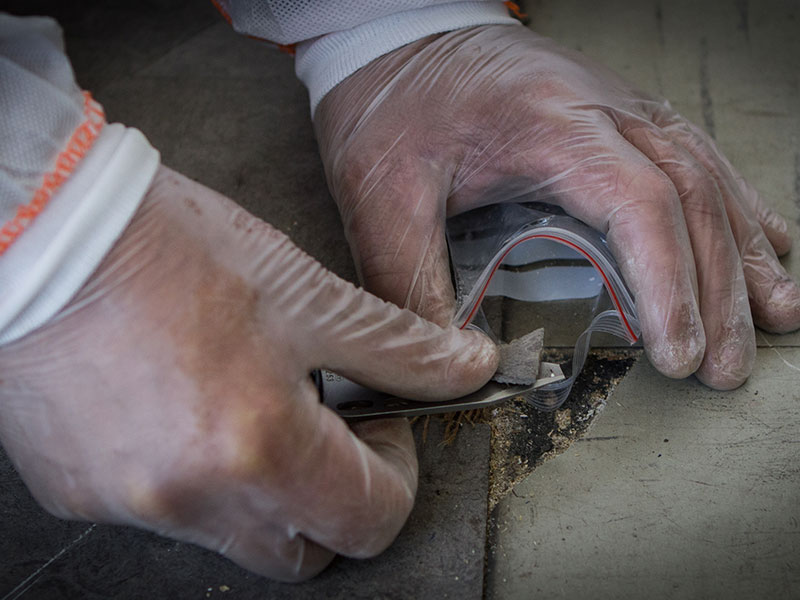What should I do if asbestos is found in a school?
The UK has banned the importation, supply, and use of asbestos since 1999. That means buildings are no longer being constructed with asbestos-containing materials. However, since many schools were constructed prior to 2000, it’s common for asbestos to still be present.
On its own, asbestos isn’t a great cause for concern. There are many buildings throughout the UK that contain asbestos and aren’t a threat to those who work there or visit on occasion.
The problem is that when asbestos goes undetected, it can be accidentally disturbed. Once asbestos fibres are released, people can breathe them in, which can cause serious health complications years in the future.
If nobody knows that asbestos exists on school property, staff, students, and other people in the area can continually breathe in those fibres without realising it.
Here’s what to do if you find the presence of asbestos on school premises.
What is the legal position about asbestos in schools?
The Health and Safety Executive (HSE) requires that schools manage asbestos risks on an ongoing basis. This is the duty holder’s responsibility. The duty holder is the person in charge of maintaining the building, and they’re also in charge of asbestos management.
Since preventing exposure is the most essential part of asbestos safety, the duty holder is legally required to manage asbestos-related risks on the premises. This includes:
- Identifying where asbestos is present and the type of asbestos present
- Assessing the condition of the asbestos
- Managing asbestos risk so that people are not exposed to the dangerous fibres
- Regularly inspecting the asbestos materials to ensure they’re not posing a risk
It’s important that schools have up-to-date plans for managing asbestos and knowing what to do in case of an emergency. If work on a building causes structural damage or leads to other problems, it’s possible that the school will need to close temporarily.
The HSE’s Asbestos Management Checklist for Schools can be a helpful guide if your property contains asbestos-containing materials.
What to do if asbestos is found in a school
The presence of asbestos isn’t a danger on its own. However, if asbestos materials are damaged, they release small fibres that can cause major health problems if breathed in.
If there’s asbestos in a school and you’re unsure of whether or not it poses a risk — or you’re certain it does pose a risk because it’s damaged — do the following:
Stop work immediately
Those who are not licensed to work and who worry that asbestos materials have been disturbed should stop working immediately. This will limit how much damage is caused to the asbestos materials.
Evacuate the premises
You and anyone else in the vicinity should evacuate the area immediately. This will prevent unnecessary asbestos exposure.
The exception is if you have asbestos debris or dust on your clothing. In that case, you need to prevent the spread of asbestos fibres. Stay where you are for the time being.
Prevent the spread of asbestos fibres
If there’s asbestos on your clothing, stay put and move around as little as possible. To minimise the risk to yourself, put on protective respiratory equipment.
Using damp rags, wipe yourself down. It’s important that you don’t use your hands or dry brush the dust. Doing so can make it airborne and increase its spread.
As soon as possible, dispose of your clothing and the damp rags as you would other asbestos waste. Shower and wash your hair the first chance you get, too.
Prevent access to the area
To limit asbestos exposure, prevent access to the contaminated area. It may be safest to prevent access to the entire building. Block access and display a sign that reads “Possible Asbestos Contamination.”
Since asbestos fibres can remain in the air for several days, make sure to prevent access for a long enough time. Also, once the fibres settle, they can easily become airborne again if there’s movement in the area. That’s why it’s so important to stay out of the area until it’s completely safe.
Contact an asbestos specialist for help
Get in touch with an accredited asbestos surveyor or contractor. They’ll take a sample of the material and explain the risk level to you. Certain types of asbestos are riskier than others.
You’ll also need a specialist or team who can clean up and either seal or remove the asbestos materials.
What to do after asbestos exposure?
If you or someone at the school has been exposed to asbestos, here are the next steps to take:
See your doctor
Your main priority should be your health. Make an appointment with your doctor. During your visit, provide them with as much information as possible about the asbestos event.
Report the asbestos exposure to your employer
Let your employer know right away that there’s been an asbestos exposure event. Provide details like the date of the event, how long the exposure lasted, and the type of asbestos exposed.
Similarly, if you’re a member of a trade union, you can let them know about the event as well.
Make an official report of the incident
In the UK, the Reporting of Injuries, Diseases and Dangerous Occurrences Regulations 2013 (RIDDOR) requires that dangerous workplace occurrences are reported. You can make a RIDDOR report through the HSE website here. You can also learn more about reporting RIDDOR here.
How to manage the presence of asbestos in a school
You may not be sure if the school property contains asbestos at all. Or, maybe you suspect or know it does, but you’re not sure where the asbestos is present or how much of a risk it poses.
Here’s how to manage the presence of asbestos in a school to stay in accordance with the law and keep everyone safe.
Get an asbestos survey
Get an accredited asbestos surveyor to visit the property. They’ll perform an asbestos management survey, which will detail the following:
- The location of the asbestos
- How much asbestos is present
- The type of asbestos on the premises
- The condition of the asbestos
While the survey won’t discuss how to manage asbestos risk, it is a first step toward creating a management plan.
It’s important that all areas of the school property are surveyed. This isn’t limited to the main school buildings. Surveying should also include outbuildings, pipes, storerooms, yards, etc.
Develop an asbestos management plan
The asbestos management plan lays out the process of managing asbestos on school property. It includes:
- Details about the duty holder, who is in charge of managing asbestos
- The asbestos register, which is a record of where asbestos is located and the condition of the materials
- Directions to avoid disturbing asbestos-containing materials
It’s the duty holder’s job to create and maintain the asbestos management register and plan.
Maintain and monitor known asbestos
So long as the asbestos materials remain intact, they don’t pose a risk. The duty holder is responsible for regular monitoring and maintenance of the asbestos to keep it safe. That may include visually checking the materials for signs of damage. It could also require hiring licensed professionals to repair damaged materials as needed.
Some asbestos materials that have so far remained undisturbed may not stay that way. For example, if there’s scheduled work on a part of the building, those asbestos materials could be disturbed.
Update the asbestos management plan as needed, even if that’s more frequently than the annual requirement. Also, communicate those updates to anyone who could be impacted.
If required, encapsulate or remove the asbestos
Encapsulating asbestos keeps the fibres from escaping. Often, spraying a thick sealant on exposed asbestos keeps the materials secure. Alternatively, an airtight barrier can enclose the asbestos materials.
It’s also possible that the asbestos will have to be removed and replaced with non-asbestos materials. Since working with asbestos is so risky, it’s best to leave this job to professionals.
Ensure good communication with everyone who could potentially be at risk
Anyone who could be at risk of asbestos exposure should know about its presence on the premises. Similarly, anyone in charge of others should also know details about the asbestos. Provide the necessary information before work takes place, leaving plenty of time for precautions to be set up.
Also, everyone who could be affected by the asbestos or who may be working directly with it should know where to find the asbestos register and management plan, as well as who the duty holder is.
Final thoughts
During normal school activities, teachers and students are not at a high risk of asbestos exposure. It’s important that educators, staff, and contractors know where asbestos is present, though.
Something as simple as pinning up a project to a classroom wall can disturb asbestos and release fibres. Also, as contractors perform major work on the buildings or other parts of the property, they should know where asbestos is so they can take the necessary precautions.
If you suspect that your school has asbestos on the premises, contact us today to discuss our services.

Written by Mark Carter
Mark Carter is a renowned expert in asbestos management, offering clients vital guidance on compliance and safety. His expertise is invaluable for navigating asbestos regulations, ensuring both safety and legal adherence. Mark's role is central in providing effective asbestos-related solutions, helping clients achieve their business objectives with an emphasis on regulatory compliance and safety in asbestos management.

